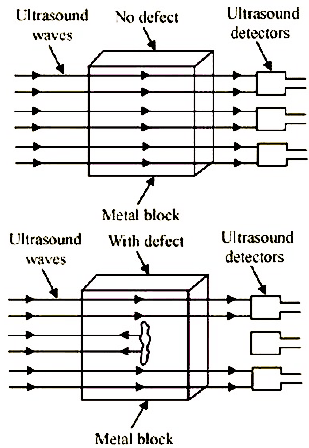Explain how defects in a metal block can be detected using ultrasound.
Ultrasonic testing detects defects in metal blocks by analyzing how high-frequency sound waves behave when interacting with the material. Defects like cracks or holes prevent the waves from traveling through the metal, causing them to be reflected instead. By detecting these reflected waves, or the lack of transmitted waves, flaws can be identified.
Here’s a more detailed explanation:
1. Sending Ultrasound:
A transducer emits high-frequency sound waves (ultrasound) into the metal block.
2. Wave Propagation:
In a defect-free metal, the ultrasound waves travel through the material, and detectors on the opposite side can receive them.
3. Defect Encounter:
If a defect (like a crack or a hole) is present, the ultrasound waves encounter an impedance change at the defect, causing them to be reflected back.
4. Detecting Reflected Waves:
Detectors can pick up these reflected waves, indicating the presence of a defect.
5. Analyzing the Signals:
The nature and strength of the reflected waves can provide information about the size, location, and type of defect.
6. No Signal, No Defect:
If no reflected waves are detected, it suggests that the ultrasound waves have traveled unimpeded through the material, indicating a defect-free zone.
